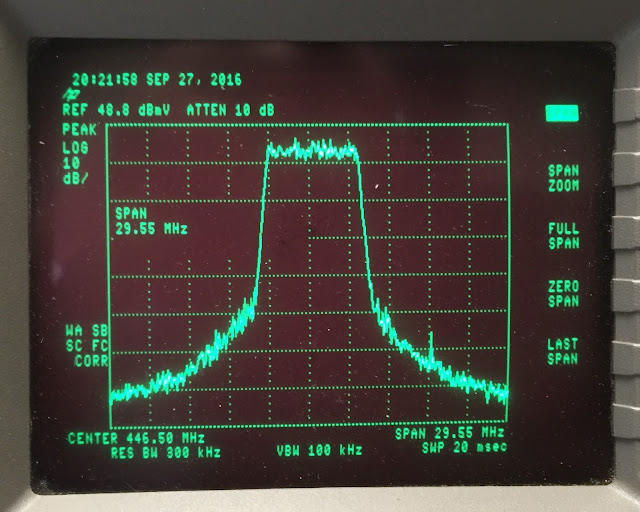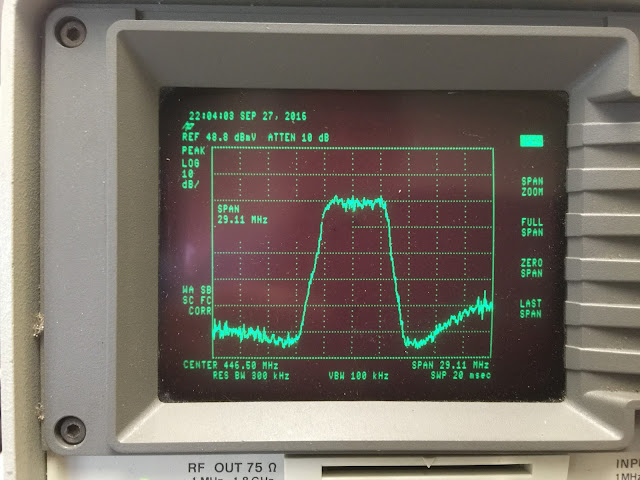Testing a duplexer as a DVB-T TX filter-Wow!
Testing a cheap Chinese duplexer as a 70cm DATV DVB-T 7 MHz TX filter- Wow!
Introduction
In my last post I described a cheap Chinese duplexer re-tuned as 70 cm DATV DVB-T 7 MHz TX filter. The duplexer uses notch cavity filters, six in all. The notch filters have a much sharper edge, compared to a band-pass filter. The sharp notch seems suited to the vertical edges of a DVB-T signal.I initially check the signal source, a HiDes camera with direct DVB-T output at 1080P. I was a little surprised at the spread, but the filter cleaned it up well. This would indicate the need for a filter before the main power amplifier.
I pressed on with just one filter and tried it at the output of the amplifier, a 10 W device, from Darko OE7DBH, using a RA60H4047M1 60 W module. Even with the indifferent input, the filter was able to reduce the spread to -60 dB and give a clean 10 W output.
The notch duplexer/filter seems to overcome some of the major hurdles with DVB-T amplifiers and warrants further investigation.
I have not investigated the effects of the filter and different power levels on signal quality at the receiver. I have limited instrumentation, but will report my findings in the next post.
Instrumentation
A 20 dB directional coupler, plus an additional 30 dB of attenuation, was used to tap a signal from the transmit path to a HP 8591A spectrum analyser. A cheap SWR/Power meter was used in line to give some idea of output.Filter before the amplifier
The duplexer/filter works remarkably well. In setting up to test the amplifier, I checked the source from a HiDes camera with direct DVB-T output; 7MHz channel, centered on 446.5 MHz, just to check it was clean. It wasn't too good, acceptable maybe at -40 dB, but with quite a spread.
Inserting the duplexer/filter cleaned it up almost perfectly!
Now I need another duplexer/filter to put after the amplifier.
Preliminary tests with just output filter
With the amount of gear needed to test a DVB-T amplifier, I thought I might see how the filter works, even with the less than perfect signal from the camera source.With no filter and adjusting the input to keep spread at about -30 dB gives about 6 W, but it is not pretty.
Filter after the amplifier
With the filter after the amplfier, the results are surprising; with adjustment, a clean 10 W signal. The spread is 60 dB down. Magic! Drawing about 8 A at 13.8 V.The power meter is showing 10 W. However I am not sure that is the full envelope power of a 7 MHz wide DVB-T signal. Cheap meters are for measuring low bandwidth CW and SSB signals, not complex ones. (I would like this clarified/explained by someone in the Yahoo group).
For amusement, I tried the direct signal input, thus over-driving the amplifier and putting out a few extra Watts of power.
The result shows the notch-nature of the cavities and duplexer. There is some rubbish, still -40 dB, above and below the filter's two notches.
Taking out the filter, and about 20 W output, with terrible spread. It sure does some clean-up job!
Conclusion
The notch duplexer/filter seems to overcome many of the problems of amplifiers for DVB-T.A filter seems to be needed both before and after the main power amplifier.
There is still probably a need for a lowpass filter to stop harmonics.
The received signal quality needs to be checked.
This is a preliminary study and needs to be tried by others.
I again thank Martin VK4JVC for suggesting a duplexer rather than building an interdigital filter.







Comments
Post a Comment